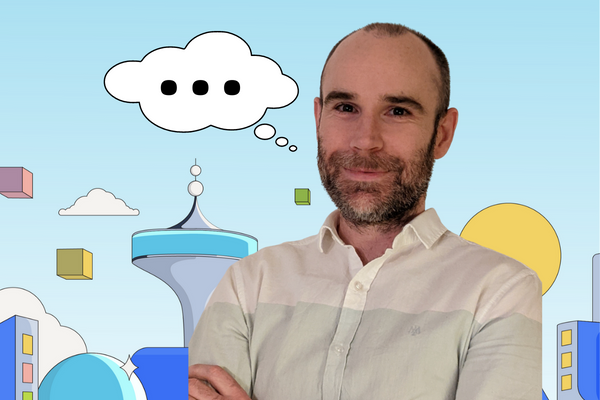Tackling the ins and outs of international tech solution teamwork with Alan

Leading a global team of Dropboxers who are all working within our Virtual First model requires intentionality. How do you continue to build meaningful connections, support career growth, and drive business results, all while keeping your own workday under control? International Head of Technical Solutions Alan Brennan gave us an inside peek at his secrets to success.
What was the transition moving from regional to global like? What had to shift in your role?
I initially joined to lead the EMEA tech solutions team in mid 2019, and my role expanded to cover what is now referred to as the International region in 2020. I had managed a global presales team in my previous company and was lucky enough to travel to most regions, but I didn’t have as much exposure to the Japan region, which is a key market for us. The big adjustment has been thinking strategically around implementing scaled programs that will resonate in different markets. I’ve had to pay more attention to balancing the cost of customer acquisition and demands on our team while optimising for increased customer lifetime value.
How do you manage time zones and Core Collaboration Hours (CCH) in your role?
I won’t lie, this can be tricky on both fronts. I lead the Tech Solutions International team from Dublin, so with folks in Japan and Sydney, the time difference often means early starts. Throw in a feisty threenager and a wife who is also in a global tech role, and the mornings can be pretty chaotic. So on Sunday evenings, we sit together to coordinate calendars and plan drop-offs and pick-ups for the week ahead.
What I love about Dropbox is the flexibility and support the company provides to be present with family. But of course, like with any customer-facing role, CCH means you are at the behest of a customer’s schedule. So while I deliberately add CCH hours to calendar for head down focused work, there is an acknowledgment of the need to flex as needed.
What are some practical ways you stay connected to your direct reports and ensure impact in their role, setting them up for success and career growth?
For myself, I need that personal touch to stay connected. When it has been safe to do so, we get out and gather as a team (team hikes, golf, dinners, etc). That has helped forge closer connections, especially with a new team in its forming stage.
Following that and to help demonstrate impact, we use OKRs (Objectives and Key Results). At the start of each year as a team, we define the key pillars (objectives) we want to get behind. The KRs and tactics are reviewed and adjusted quarterly, but the overarching objectives remain constant. Then each team member defines their own OKRs encompassing career goals and focus areas laddering up to org and company wide objectives. Our aim is to help team members stay focused but also see the impact they are having upstream by connecting their day-day to the bigger picture.
How does Dropbox invest in your leadership growth?
A couple of years ago I was fortunate to participate in an external course on personal development, leadership, and executive coaching. This was a significant self investment through which I was really pushed out of my comfort zone but gleaned a lot of confidence, as well as tools and techniques to help with leading a team.
More recently, I’ve been lucky to participate in the Manager’s Summit program at Dropbox. Having such a reputable program (sponsored by our CEO Drew) is testament to the value Dropbox places in developing well-rounded leaders to navigate a lot of ambiguity and complexity in today’s workplace. I’m probably one of the youngest on that program so am definitely taking a position of “listening to learn” from such a phenomenal cohort of Dropbox leaders.
How do you maintain culture on your team without an office?
I recently read “Above The Line” by Urban Meyer and really liked how he framed it from a sporting point of view. The foundation of culture is core beliefs, namely:
- What we believe (e.g. relentless focus on the customer, competitive excellence, power of the team)
- How we behave
- Outcome we achieve
Culture ultimately drives behavior and behavior produces results. In Virtual First, I believe we can still preserve a high performing culture using coaching as a leadership style. This requires giving our teams clarity of purpose and tools that empower them, and ensuring we have deep trust, high standards, and accountability. For me, OKRs are a great framework to achieve this, especially when leaders can adjust their coaching style to best suit the different personality types, learning styles, motivations, and strengths among their team members.
What keys do you think can help someone thrive in Virtual First?
From what I’ve seen thus far, those who thrive seem to place a premium on autonomy and flexibility, and are naturally independent, hard-working, and trustworthy. I also feel we really thrive when we adapt that mindset of interdependence (“we are all in it together”). I feel it’s incumbent upon team leads to design work arrangements that offer equal opportunity to all team members—regardless of location—to express their power and demonstrate their impact.
What part of Virtual First allows you to be most successful in your role?
The time outside Core Collaboration Hours serve as a built in buffer each day for head down, undistracted focus work. Without this, we’re on the hamster wheel doing busy work. So the acknowledgement of this from the top has helped me shift from operational to strategic leadership. I still have things I need to improve, but this time certainly enables me to find my focus, filter the noise, and follow through on commitments.